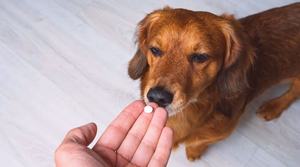
Reviewed & Fact-Checked by
Dr. Paula Simons
Veterinarian (DVM)
Learn more about our Veterinary Review Board »
All pups, large or small, need strong, healthy muscles to thrive and truly enjoy themselves.
There are some canine diseases that make that hard however, and can lead to their muscles wasting away. One such condition is polymyositis in dogs.
What is Polymyositis?
Polymyositis is one of two more common disorders that are classified as myopathies - muscle diseases - that can adversely affect muscle movement, muscle strength and muscle tone in adult dogs.
It is an inflammatory muscle disorder that affects a pup's skeletal muscles but, unlike the other disorder - dermatomyositis - it does not cause lesions or lead to pus filled swellings, so can be harder to detect.
Polymyositis is not an infectious condition that can be passed from one pup to another.
It may develop slowly over time and last for extended periods of time or it may present itself as a short term episode that, once properly treated, subsides.
What Causes Polymyositis?
Exactly what causes polymyositis in dogs is still a matter of debate and research in veterinary medicine circles. It's usually classified as an immune mediated disease, meaning that an abnormal immune system response triggers symptoms.
Sometimes canine polymyositis will occur along with another immune mediated condition like the aforementioned dermatomyositis or a condition called megaesophagus, which may complicate or lengthen effective treatment.
Although it is still not understood why, research has shown that some breeds of dog do seem to be more susceptible to developing polymyositis, such as Newfoundlands, Vizslas, Pembroke Welsh Corgis and Boxer dogs.
It is not known if a genetic abnormality exists in these breeds, but as a general precaution most breeders will not breed a pup that has suffered from the disease in case that is a possibility.
In addition polymyositis in dogs can be the result of a reaction to certain medications and may also manifest as a secondary symptom of cancer.
How Can I Tell if My Dog has Polymyositis?
There are a number of signs that may indicate that your pup is suffering from polymyositis, including all the following:
- Lethargy
- Apparent weakness
- Pyrexia aka fever
- Lameness and/or limping
- Loss of appetite (anorexia)
- Apparent depression
- Muscle pain (areas that seem tender to the touch)
- Muscle loss and muscle wasting
If a pup also has dermatomyositis, lesions and visible swellings may appear, but that will not be the case if he is only suffering from polymyositis.
There can also be symptoms of other health conditions in pups, but should your dog seem to be experiencing any of them he should be seen by his vet as soon as possible. Prompt treatment can make all the difference to his long term prognosis in a very positive way.
How is Polymyositis in Dogs Diagnosed?
Diagnosing polymyositis in dogs often involves a good amount of testing.
After performing a thorough general examination to rule out other causes of the symptoms, your vet will order complete blood count and a urinalysis to rule out other diseases and to check for, and the levels of, a muscle enzyme called creatine kinase (CK).
CK is a naturally occurring enzyme expressed by muscle tissue. When CK levels rise too high secondary to muscle damage so in a dog suffering from polymyositis those levels are likely to be elevated.
A vet may also order and perform a muscle biopsy to determine the level of muscle damage present and to achieve a definitive diagnosis.
How is Canine Polymyositis Treated?
It should be noted that there is no 'cure' for polymyositis and even though one bout may subside the condition may reoccur.
In some unfortunate cases, the symptoms are so severe that they cannot be effectively treated and to avoid excessive pain and suffering euthanasia may be advised.
If polymyositis is discovered to be a secondary symptom to cancer, the prognosis and treatment options will likely change dramatically.
This, however, is a worst case scenario and more often dogs with polymyositis can be effectively treated for the condition.
Usually vets turn to immunosuppressant drugs to treat polymyositis such as prednisone along with an initial course of antibiotics if dermatomyositis is also present. If it is not, as there is no active infection present they are unnecessary.
This can be confusing for some pet parents. They may have heard of other dogs with similar conditions being given antibiotics and wonder why theirs is not.
The fact is that if only polymyositis is present, something that will have been determined by your vet by the blood tests ordered, antibiotics are not needed, and as antibiotic misuse can have serious effects on your pup's health overall they should be avoided.
In serious cases steroids may be prescribed along with the immunosuppressant drugs and pain medications may be considered for short term use. How long steroids and immunosuppressants will need to be taken for will depend on how well the pup recovers.
Polymyositis Recovery, Prognosis and Prevention
In many cases, as long as treatment was received promptly and all the vet's recommendations were followed a dog can make a good recovery from polymyositis.
One of the things that you will be responsible for is helping him rebuild the muscle strength and muscle mass he lost. This usually involves healthy exercise and a diet that contains adequate amounts of muscle building nutrients, especially protein.
This does not, however, mean that your pup has to go on a body building mission. Recovering from polymyositis may take some time and overdoing exercise will not be a good thing.
Instead, talk to your vet about the appropriate amount of exercise for your pup at each stage of his recovery and then devise a system to ensure that he gets it.
As we mentioned, there is no cure for polymyositis, so it may reoccur or 'flare up'. Observing his daily behavior - along with vet check-ups at recommended intervals - will help make sure that if that happens treatment can begin in earnest again as quickly as possible.
In terms of prevention, as the disease is not fully understood there are no known effective ways to prevent it.
If your dog is one of the breeds mentioned who seem to be more susceptible to developing disease there is little you can do except be extra vigilant when watching for symptoms and ensuring that on a daily basis they get healthy food and all the nutrition goodness that will help keep them generally healthy.



